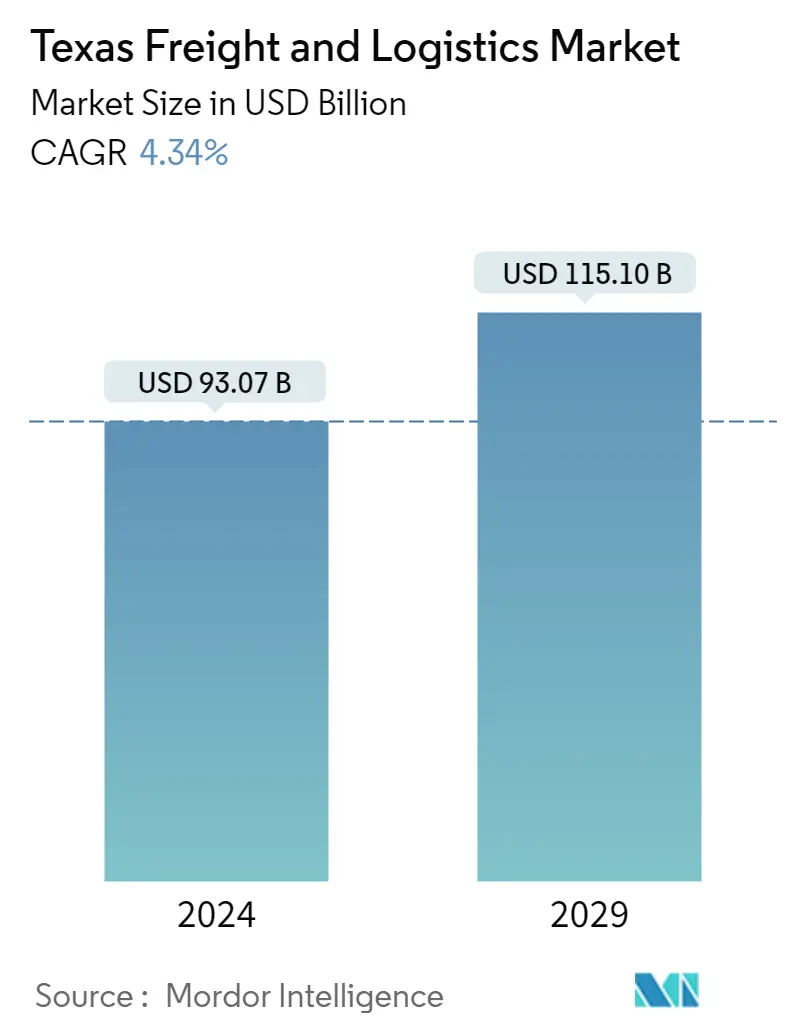Market Size of Texas Freight and Logistics Industry

| Study Period | 2020 - 2029 |
| Base Year For Estimation | 2023 |
| Market Size (2024) | USD 93.07 Billion |
| Market Size (2029) | USD 115.10 Billion |
| CAGR (2024 - 2029) | 4.34 % |
| Market Concentration | Low |
Major Players
*Disclaimer: Major Players sorted in no particular order |
Need a report that reflects how COVID-19 has impacted this market and its growth?
Texas Freight And Logistics Market Analysis
The Texas Freight and Logistics Market size is estimated at USD 93.07 billion in 2024, and is expected to reach USD 115.10 billion by 2029, growing at a CAGR of 4.34% during the forecast period (2024-2029).
The market is driven by the geographical placement of the state and the enormous transportation of goods within and out of the country that happens via Texas. Furthermore, the market is also driven by a large number of ports present in Texas.
- Texas' enormous size is a well-known fact that Texans worldwide take pride in. Only the state of Alaska is physically larger at 268,597 square miles. But Texas can claim something that even Alaska cannot: it is a major international shipping hub. The state has 29 ports of entry, including seaports (Beaumont, Corpus Christi, Freeport, Galveston, Houston, and Port Arthur), two international airports (Dallas/Fort Worth and George Bush), three land ports (El Paso, Hidalgo, and Laredo), and Intermodal Ports (Beaumont, Corpus Christi, Freeport, Galveston, Houston, and Port Arthur). Texas ports support nearly USD 450 billion in economic activity in the state and USD 1 trillion in national economic activity as international trade hubs.
- Texas shares a border with Mexico, America's second-largest trading partner. Texas is better positioned for Asian trade after the Panama Canal expansion, especially given the bottlenecks at West Coast ports. The multimodal freight transportation network supports agriculture, energy, manufacturing, defence, construction, distribution and other key industries throughout Texas. The multimodal network connects Texas businesses to domestic and international supplies, facilities, and markets. The Texas freight and logistics industry is expected to have a bright outlook in 2022, with several new trends dominating the industry.
- Texas leads the 50 states in total lane miles and has four of the top eight cities in terms of lane mileage per capita. Texas road policy is full of innovation, from well-designed private toll roads to state researchers experimenting with a "freight shuttle" system in which trucks are moved along conveyor-type medians separated from regular traffic. Texas' transportation and logistics systems are cutting-edge and forward-thinking, and it can be expected that the state will continue to lead the way in logistics and shipping support for Asian, Hispanic, and European e-commerce markets. Considering Texas is the most important state for international trade, it consists of a vast network of warehouses, manufacturing plants, roads, rail, ports, and other infrastructure. As long as Texas remains an open economy and continues to grow, and as long as the United States commits to free trade, the state will be ground zero for advanced logistics.
